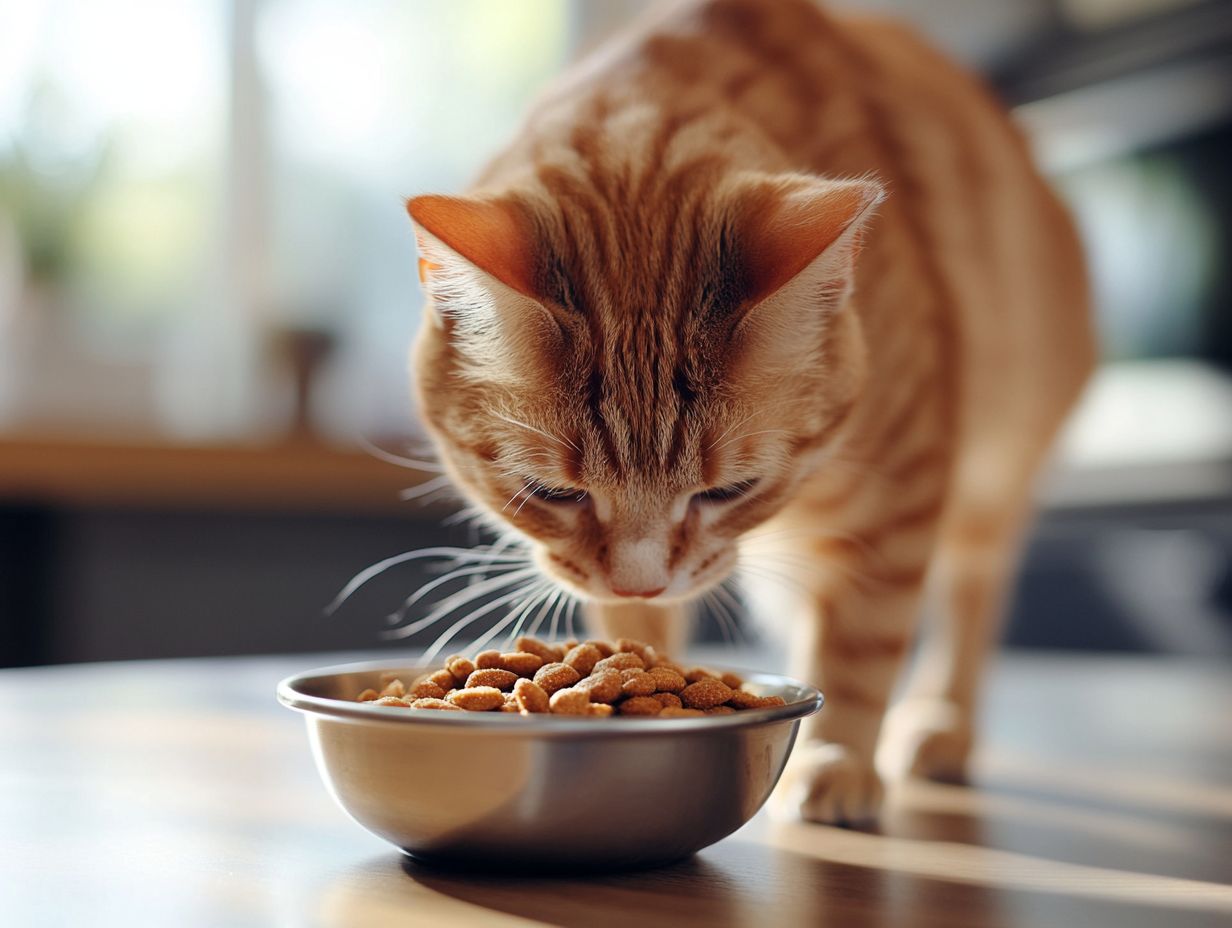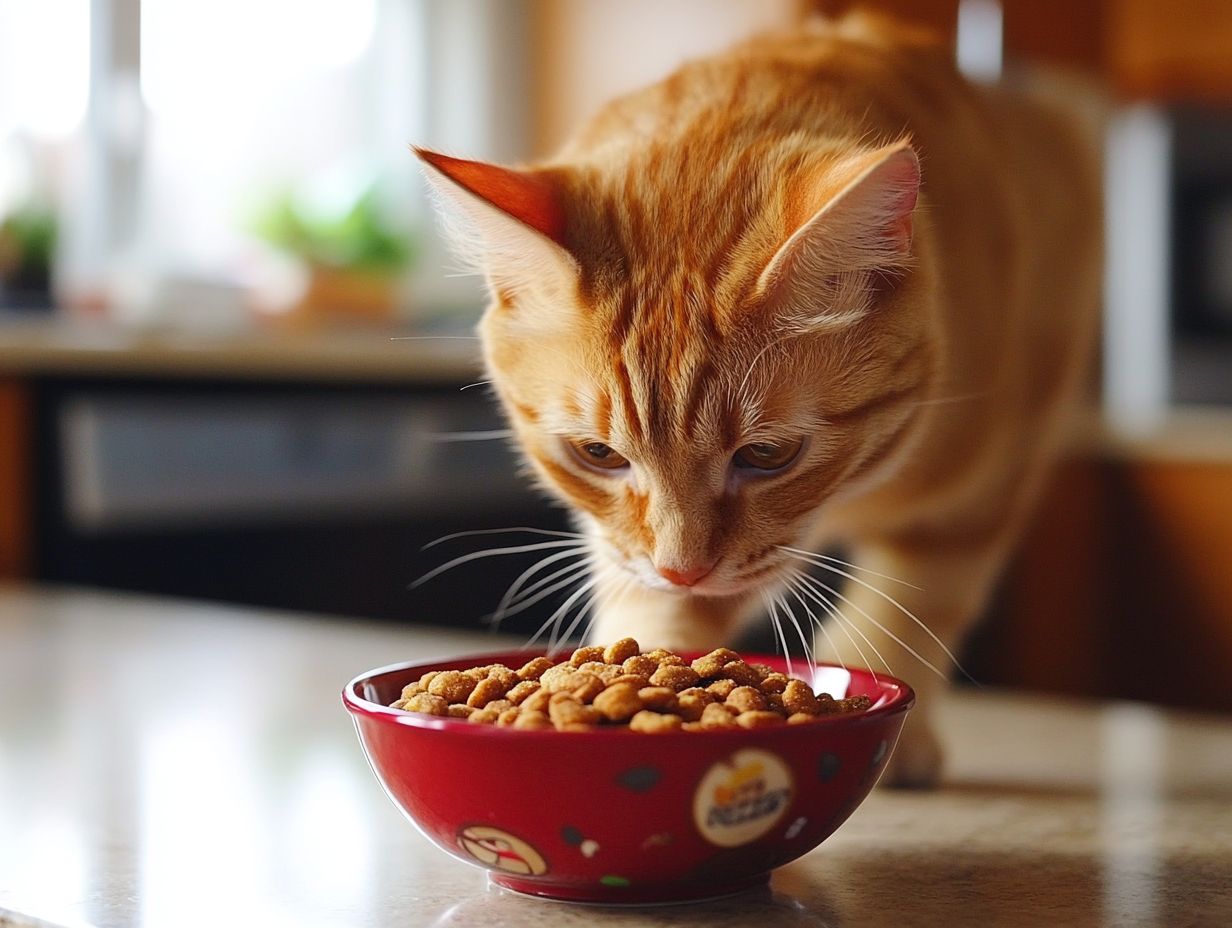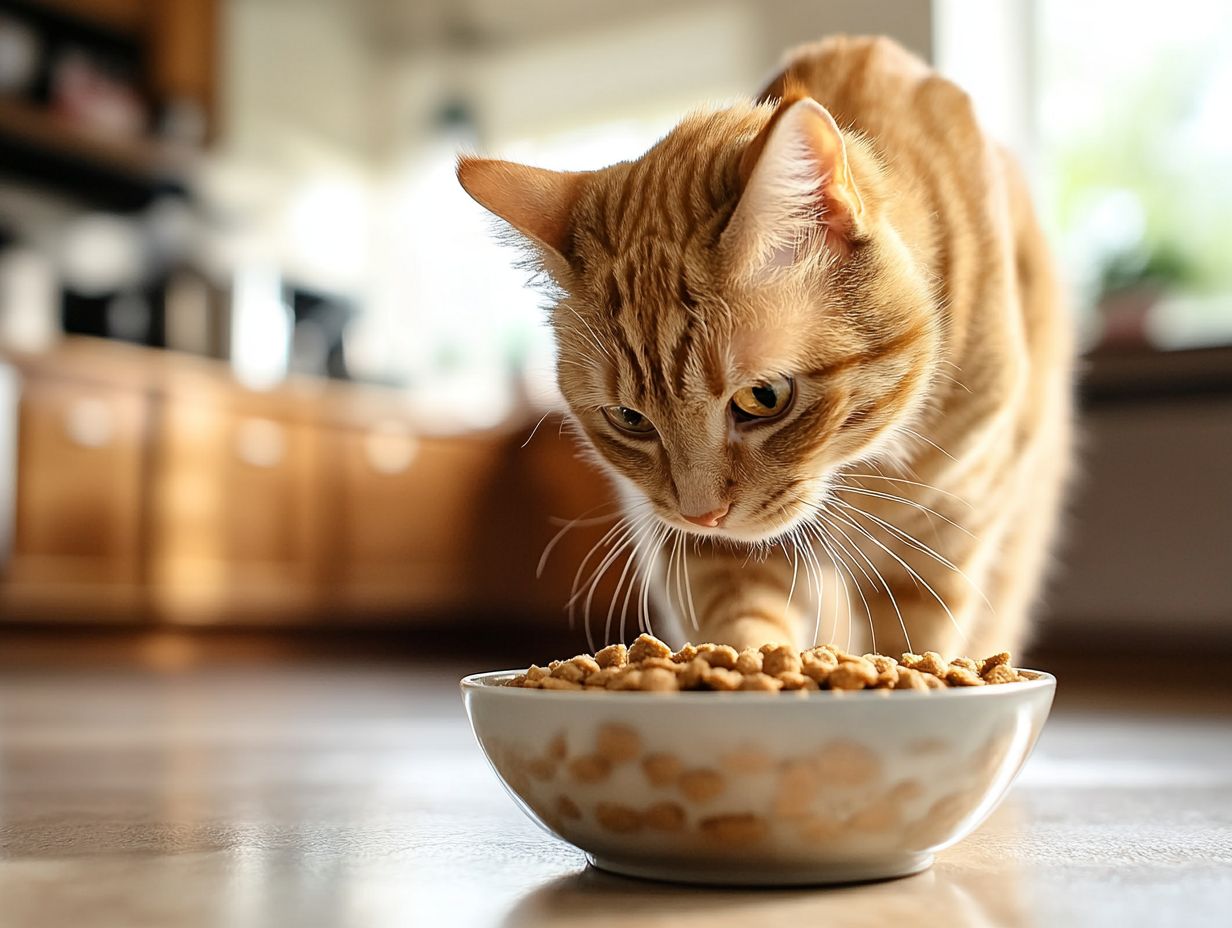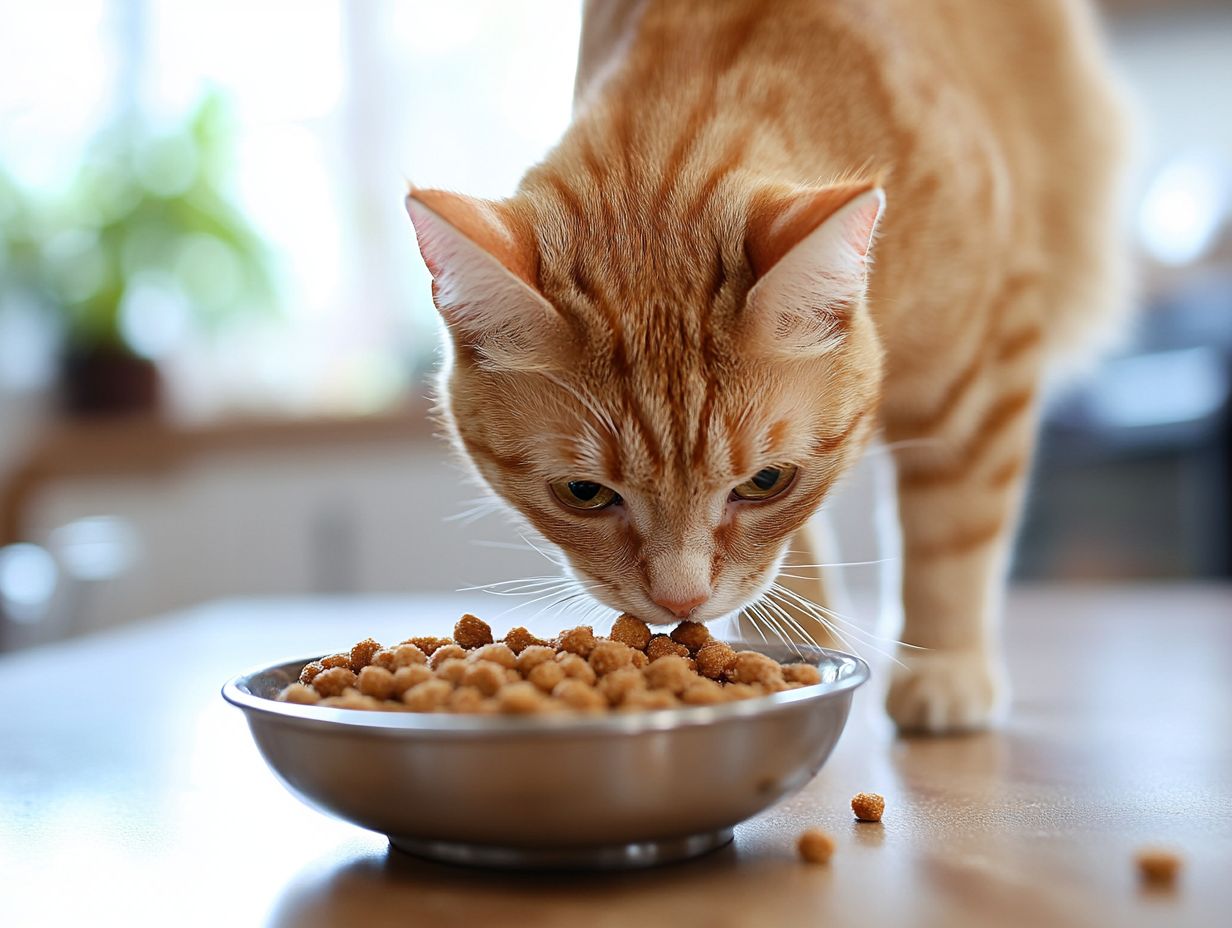Choosing the right cat food is essential for your feline friend’s health. With numerous cat food options available, grain-inclusive options often spark curiosity among pet parents in the pet food market.
These foods provide vital nutrients, support digestive and dental health, and address key aspects of feline nutrition and dietary needs.
However, there are potential benefits and risks to consider, including the impact of grain allergies and dietary sensitivities.
This article explores why grain-inclusive cat food is important, the common grains used, and what you need to know for your cat’s well-being, including insights from veterinary nutritionists.
Key Takeaways:

Why Is Grain-Inclusive Cat Food Important for Feline Nutrition?
Grain-inclusive cat food plays a crucial role in feline nutrition by providing essential nutrients necessary for a balanced diet. Understanding the significance of grain-inclusive foods empowers pet parents to make informed decisions regarding their cats’ dietary needs.
While grain-free diets have gained popularity in the pet food market, it’s important to recognize that grains offer beneficial properties, including improved digestive health, increased nutrient density, and an alternative source of protein sources.
Veterinary guidance indicates that grain-inclusive options can be beneficial for cats with specific health conditions and should be considered in holistic nutrition approaches.
1. Provides Essential Nutrients
Grain-inclusive cat food provides essential nutrients that meet feline dietary needs, promoting overall health benefits and well-being.
These nutrients are critical for cats, as their bodies require specific vitamins and minerals to function optimally. Proteins like chicken, turkey, or fish supply essential amino acids necessary for muscle maintenance, enhancing the food’s palatability and aligning with high-protein diets.
Grains such as brown rice or oats offer energy while adding fiber content to aid digestion. Additionally, grain by-products like corn gluten meal contribute essential nutrients and support a well-rounded nutrient profile, providing cost-effective food choices.
This diverse range of ingredients ensures that cats receive a balanced diet tailored to their active lifestyles, promoting long-term health.
2. Obligate Carnivore Nature
Cats are obligate carnivores, meaning their diet must primarily consist of animal proteins. This biological requirement is critical in meeting their unique nutritional needs. Non-animal-based diets can lead to deficiencies if not carefully managed, as animal-source proteins provide essential nutrients.
For optimal health and energy levels, it is essential to recognize the significance of a balanced macronutrient profile, including essential fatty acids and vitamins.
3. Supports Digestive Health
Grain-inclusive diets can aid in digestion for many cats, providing fiber that promotes gut health. However, it is essential to consult with a veterinarian to address any specific digestive concerns or health conditions, such as allergies, kidney disease, or diabetes.
Consultation with Veterinary Professionals
Before making significant dietary changes, it is strongly recommended that cat owners consult with veterinary professionals, especially when considering controversial diets like raw or homemade.
Supplementation Guidance
In some cases, dietary supplements may be necessary to ensure a balanced nutrient intake. Always align supplementation with veterinary recommendations to guarantee safety and efficacy.
Ethical Considerations
While discussing dietary choices, the primary focus should remain on the cat’s health and nutritional needs, ensuring that their dietary requirements are prioritized.
The fiber content found in grain-inclusive diets is essential for supporting digestive health, particularly for cats with dietary sensitivities. Both insoluble and soluble fiber in these diets help regulate bowel movements, preventing constipation and gastrointestinal discomfort (source: current veterinary nutrition literature). For instance, formulas that include brown rice or oatmeal not only provide highly digestible carbohydrates but also promote a healthy gut environment.
Brands typically offer specialized formulas designed for sensitive stomachs, incorporating prebiotic fibers that aid in establishing beneficial gut bacteria. These limited-ingredient formulas still deliver the essential nutrients required for optimal feline health, making them advantageous for cats prone to allergies.
4. Promotes Dental Health
Promoting dental health is a significant advantage of grain-inclusive diets, as certain ingredients can help prevent the accumulation of plaque and tartar, leading to better overall health for cats. This benefit is particularly important for cats at higher risk for dental issues.
Ingredients like highly digestible fibers and omega fatty acids contribute not only to healthy digestion but also to a favorable oral environment. Research indicates that cats with well-balanced diets rich in antioxidants are less likely to develop gum disease and inflammation.
Veterinarians often recommend regular dental examinations, professional dental cleanings, and dental chews specifically designed to combat harmful bacteria. Additionally, dental hygiene practices such as brushing and the use of specially designed toys can greatly enhance the benefits of this nutrition, ensuring that a cat’s teeth and gums remain in excellent condition throughout its life.
What Are the Common Grains Used in Commercially Available Cat Foods?
Common grains used in commercially available cat foods include corn, wheat, rice, and barley. These grains serve as essential functional ingredients, offering various nutritional benefits for cats.
Understanding these grains can empower pet parents to make informed decisions about their cat’s diet, particularly when selecting budget-friendly foods that still maintain a balanced nutrition profile with natural ingredients. However, it is important to remember that while grains can provide certain benefits, they should not replace the primary protein sources derived from animal products, reinforcing the obligate carnivore nature of cats.
1. Corn

Corn is a commonly used carbohydrate source in cat food, providing energy and essential nutrients that enhance the nutritional profile of feline diets. This grain can also serve as a source of protein and is often included in formulations designed to support a balanced diet by offering vitamins, minerals, and fiber content.
However, some pet owners question its role due to potential drawbacks, such as allergies or sensitivities in certain cats. Signs to watch for include itching, gastrointestinal issues, and skin irritations. While corn can be beneficial, especially for meeting energy needs, it is important to remember that cats are obligate carnivores, primarily requiring animal-based proteins.
The balance of carbohydrates and proteins in cat food is crucial for overall health, making it vital to choose high-quality ingredients that align with a cat’s dietary needs.
2. Wheat
Wheat is a common grain found in cat food and contains gluten, which can be either beneficial or detrimental depending on whether a cat has dietary sensitivities to gluten or wheat in general. Wheat contributes moderate nutrition in the form of carbohydrates and some protein. For many cats, it serves as a useful energy source and provides essential nutrients when included in the proper proportions.
However, it is crucial to note that not all cats will benefit from diets that contain this grain. Signs of adverse reactions can include gastrointestinal disturbances or skin irritations if they are sensitive or allergic to gluten or other components of wheat.
Therefore, understanding a cat’s dietary requirements is essential for pet owners to promote optimal health.
3. Rice
Rice is commonly included in cat food because it is easy for cats to digest, making it a popular source of carbohydrates for those with sensitive stomachs or dietary restrictions. It acts as a healthy filler that provides energy while being hypoallergenic, meaning it has a low likelihood of causing allergic reactions in sensitive cats.
While rice serves as a filler in cat food, it is a beneficial one. Due to its digestibility, rice is often incorporated into specialty diets for cats with specific health concerns, as prescribed by veterinarians.
4. Barley
Barley is used in some cat foods as a source of fiber and energy, and it can help in maintaining healthy digestion. However, excessive amounts of grains like barley can lead to a grain-heavy diet, which may risk inadequate animal protein intake and nutritional imbalances.
In conclusion, while grain-inclusive diets can provide certain benefits, it is crucial for pet owners to consult with a veterinarian before making dietary changes, especially for cats with sensitivities or chronic conditions. A balanced, well-researched diet that meets the specific needs of individual cats, particularly in different life stages, is essential for maintaining optimal feline health.
Barley offers some fiber benefits for cats, but it’s crucial to remember that cats are obligate carnivores with different fiber needs compared to omnivorous species. While barley can provide some fiber, it should not be the primary ingredient in a cat’s diet. It’s essential that protein from animal sources remains the main focus for optimal health.
This grain can create a sense of fullness, which may help with weight management. However, it is important to understand that relying on grains might not meet a cat’s nutritional needs adequately. Always prioritize high-quality animal-source proteins in a balanced diet.
What Are the Potential Benefits of Grain-Inclusive Cat Food?
Grain-inclusive cat food may offer some benefits, including improved digestion, increased energy levels, healthier skin and coat, and enhanced overall health. However, pet parents, especially those concerned with feline nutrition and dietary sensitivities, should be cautious and consult a veterinarian before making significant dietary changes.
1. Improved Digestion
One of the potential benefits of grain-inclusive cat food is improved digestion. While the fiber in these foods can promote gastrointestinal health and regularity, it’s important to note the risks of introducing grains, particularly for cats with dietary sensitivities or allergies. The inclusion of natural grains, such as brown rice or oats, may encourage the growth of beneficial gut bacteria, but caution is advised.
These ingredients can enhance the food’s palatability and may aid in digestion. However, pet owners should consider that protein from animal sources is more crucial for their cat’s overall health. Foods containing prebiotics and probiotics can further support digestive health, but always consult a veterinarian for personalized recommendations.
2. Increased Energy Levels
One major benefit of grain-inclusive cat food is that it can provide energy, but the primary energy sources for cats should come from animal proteins and fats. This is particularly important for active cats.
A balanced diet supports muscle growth and maintenance while promoting sustained endurance. For younger cats, adequate protein helps fuel energetic activities and exploration. For older cats, maintaining muscle mass and encouraging a healthy weight can support mobility and overall vitality.
3. Healthier Skin and Coat

A healthier skin and coat is a commonly noted benefit of grain-inclusive cat food, but the key to achieving this lies in proper nutrition that emphasizes animal fats and proteins. Nutrients such as omega-3 and omega-6 fatty acids are crucial for maintaining intact skin cells and promoting a healthy coat.
By adopting a balanced approach to feline nutrition, pet owners can help ensure that their cats receive the necessary vitamins and minerals without over-relying on grains. This strategy can improve skin conditions, reduce shedding, and enhance coat sheen.
4. Better Overall Health
One benefit of grain-inclusive cat food is its nutritional profile, which can address various feline health issues. However, it’s essential to remember that while these diets may offer some advantages, the focus should always be on high-quality animal proteins and essential fatty acids. Monitoring cat health with the assistance of a veterinarian is crucial.
Additionally, it’s vital to ensure balanced nutrition that considers life stage and any particular health issues. Always seek veterinary guidance tailored to your cat’s specific needs.
Finally, when handling both grain-inclusive and grain-free cat food, proper storage is important. Keep food in a cool, dry place, and ensure it’s sealed to prevent spoilage. Always check for expiration dates to ensure safety and quality.
For this reason, it is crucial for cat owners to seek veterinary guidance when selecting food, especially if their cats are facing specific health challenges such as allergies or diabetes. While grain-inclusive options can be beneficial, they should be approached with caution, particularly for cats with specific dietary needs. A veterinarian can recommend suitable grain-inclusive options based on each cat’s unique characteristics, ensuring that the chosen food not only meets nutritional needs but also supports overall health, ultimately improving quality of life. Understanding cat dietary needs, including food allergies and health conditions, is essential for making informed healthy choices.
Are There Any Risks Associated with Grain-Inclusive Cat Food?
Grain-inclusive cat food offers several benefits, but it can also present risks that require awareness. Potential negative effects, such as food sensitivity and grain allergies, may necessitate a veterinary diagnosis. It is important for pet owners to understand that not all cats will react negatively to grains, and to make the best dietary choices for their pets based on individual health needs.
1. Allergies and Sensitivities
Allergies and sensitivities are significant concerns with grain-inclusive cat food, particularly for cats diagnosed with grain allergies or food sensitivities. This situation necessitates careful selection of cat food, considering grain-free diets as potential alternatives.
Many cats can develop adverse reactions not only to grains but also to other common ingredients found in commercial diets, such as chicken or fish. These reactions can range from itching and gastrointestinal upset to more severe complications that may require veterinary treatment.
Veterinarians can provide valuable guidance; they can help identify specific allergens through elimination dietary trials and offer tailored recommendations for grain-free or hypoallergenic food options. Additionally, cats should be monitored regularly for any signs of allergies, as symptoms can change over time.
2. Weight Gain
Weight gain is a potential risk associated with grain-inclusive cat food, particularly when the food lacks balanced nutrition or when cats are overfed, leading to obesity. Exploring high-protein diets and nutritional profile considerations can aid in managing this risk. Current feline obesity guidelines from authoritative organizations like AAFCO or WSAVA can provide a useful framework for weight management strategies. Therefore, careful dietary management by pet parents is essential.
To prevent unhealthy weight gain, it is important for guardians to control portion sizes and understand the nutritional composition of these foods. Selecting high-quality grains that provide essential nutrients is crucial. Additionally, incorporating a variety of protein sources can contribute to a well-rounded dietary balance.
Establishing a regular feeding schedule instead of free feeding can help control caloric intake. Moreover, engaging in playtime and scheduling regular veterinary check-ups can further assist in preventing excessive weight gain.
3. Dental Issues
Cats can experience dental issues due to certain grain-inclusive cat food options, which may lead to plaque buildup and other complications. Pet owners should be vigilant about their cat’s oral hygiene. Certain grains, especially those that are processed or high in carbohydrates, can promote the growth of harmful bacteria in the mouth, resulting in tartar and gum disease. When selecting cat food, it’s important to carefully monitor the ingredient list, as some ingredients are more beneficial for dental health than others. For more information, check out Grain-Inclusive Cat Food: Understanding Its Role in Feline Nutrition.
Incorporating crunchy textures into cat food can help mechanically remove plaque as cats chew, thereby contributing to better dental health. Along with food choices, regular brushing and dental treats specifically designed for cats can significantly improve their oral health and help maintain their smiles. It’s also important to consult with a veterinarian for tailored dental care strategies, reinforcing the need for professional guidance.
4. Digestive Problems
Cats that consume grain-containing diets may experience digestive problems, particularly if those diets do not align with their dietary sensitivities. This underscores the importance of making informed and healthy choices based on veterinary guidance. When cats ingest ingredients their bodies cannot process, they may suffer from bloating, diarrhea, and discomfort. Recognizing that cats are obligate carnivores and may struggle to digest grains is crucial for their health. Transitioning to new diets should be done gradually to prevent digestive upset.
Additionally, monitoring food storage practices is crucial for maintaining the nutritional integrity of cat food. Improper storage can lead to spoilage, affecting your cat’s health.
While grain-free diets may be suitable for some cats, they should not be universally recommended without veterinary input. In conclusion, seeking veterinary guidance is essential for making informed dietary choices for cats, ensuring a balanced perspective on grain-inclusive and alternative diets.
To ensure their pets receive proper nutrition, owners should seek veterinarians who can provide tailored recommendations based on specific health needs. When selecting food options, it is beneficial to choose products that contain high-quality protein and minimal low-quality fillers, such as those found in grain-free food, thereby supporting a diet that meets their obligate carnivorous needs. According to AAFCO and WSAVA guidelines, understanding these nutritional requirements is essential for optimal health.
Frequently Asked Questions

What is grain-inclusive cat food and why is it important for feline nutrition?
Grain-inclusive cat food refers to cat food that contains a variety of grains, such as wheat, corn, or rice, as a source of carbohydrates for energy. While these grains provide essential nutrients and energy, it’s important to note that cats require animal proteins as their primary source of nutrition, making grain-inclusive options a part of a well-rounded nutrient profile.
What are the benefits of including grains in a cat’s diet?
Grains in cat food provide a balance of carbohydrates, protein, and fats, which are all necessary for a cat’s growth and development. In addition, grains also contain fiber, vitamins, and minerals that promote a healthy digestive system and support overall wellness. However, some cats may have allergenic responses to grains, so it’s essential to monitor fiber content and carbohydrate sources to ensure the overall diet is still high in animal protein.
Are there any cats that should not consume grain-inclusive cat food?
Generally, most cats can benefit from a diet that includes grains. However, for cats with certain health conditions, such as grain allergies or sensitivities, it may be necessary to avoid grains. Any dietary changes should be made under veterinary guidance, particularly for cats with underlying health conditions, to determine the best diet for your individual cat and consider the grain-free trend.
How can I determine if a grain-inclusive cat food is of good quality?
When choosing a grain-inclusive cat food, it’s important to look at the ingredients list. The first few ingredients should be high-quality animal protein sources, such as chicken, fish, or turkey. Avoid cat food that includes fillers, artificial preservatives, or by-products. Additionally, monitoring portion sizes can help manage your cat’s weight effectively. Checking ingredient labels can ensure you make healthy choices.
Can grain-inclusive cat food be used for weight management in cats?
Yes, grain-inclusive cat food can be used for weight management in cats. Grains provide a balance of nutrients and help cats feel full and satisfied. This is an essential part of feline nutrition. It’s important to consult with a veterinarian to determine the appropriate amount to feed your cat based on their individual needs, considering balanced calorie intake and regular veterinary check-ups to monitor health.
Are there any potential drawbacks to feeding my cat grain-inclusive cat food, considering the grain-free trend?
For most cats, there are no drawbacks to consuming grain-inclusive cat food. However, some cats with certain health conditions, such as diabetes, may need a diet lower in carbohydrates or specific dietary sensitivities addressed, possibly through grain-free cat food. Consulting with veterinary nutritionists can provide insights into healthy choices and cat dietary requirements. As always, it’s important to consult with a veterinarian to determine the best diet for your individual cat, considering the grain-free diets and other pet food trends.
Proper Food Storage and Handling
To prevent health risks, proper food storage and handling are essential. Always store dry food in a cool, dry place and seal it tightly after opening. Wet food should be refrigerated after opening and used within a few days. Check for spoilage by looking for unusual odors or changes in texture, both in dry and wet cat food.